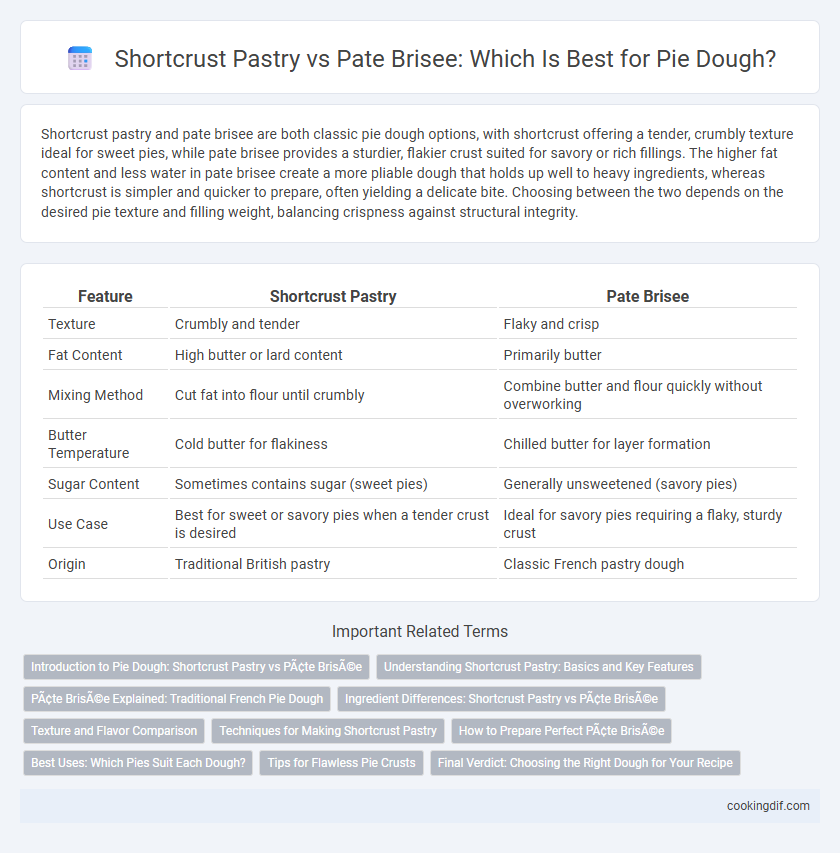Shortcrust pastry and pate brisee are both classic pie dough options, with shortcrust offering a tender, crumbly texture ideal for sweet pies, while pate brisee provides a sturdier, flakier crust suited for savory or rich fillings. The higher fat content and less water in pate brisee create a more pliable dough that holds up well to heavy ingredients, whereas shortcrust is simpler and quicker to prepare, often yielding a delicate bite. Choosing between the two depends on the desired pie texture and filling weight, balancing crispness against structural integrity.
Table of Comparison
| Feature | Shortcrust Pastry | Pate Brisee |
|---|---|---|
| Texture | Crumbly and tender | Flaky and crisp |
| Fat Content | High butter or lard content | Primarily butter |
| Mixing Method | Cut fat into flour until crumbly | Combine butter and flour quickly without overworking |
| Butter Temperature | Cold butter for flakiness | Chilled butter for layer formation |
| Sugar Content | Sometimes contains sugar (sweet pies) | Generally unsweetened (savory pies) |
| Use Case | Best for sweet or savory pies when a tender crust is desired | Ideal for savory pies requiring a flaky, sturdy crust |
| Origin | Traditional British pastry | Classic French pastry dough |
Introduction to Pie Dough: Shortcrust Pastry vs Pâte Brisée
Shortcrust pastry and pate brisee are two foundational types of pie dough, each offering distinct textures and uses. Shortcrust pastry typically combines flour, fat, and a small amount of water, producing a tender and crumbly crust ideal for sweet and savory pies. Pate brisee includes egg and sometimes sugar, resulting in a richer, flakier dough that holds its shape well for elegant tarts and quiches.
Understanding Shortcrust Pastry: Basics and Key Features
Shortcrust pastry is a foundational dough known for its tender, crumbly texture achieved by combining flour, fat, and minimal liquid without overworking the ingredients. It typically uses cold butter or lard cut into the flour to create a flaky yet sturdy structure ideal for both sweet and savory pies. The dough's low moisture content and gentle handling prevent gluten development, resulting in a crisp crust that holds fillings well.
Pâte Brisée Explained: Traditional French Pie Dough
Pate brisee is a classic French pie dough known for its tender, flaky texture achieved through a delicate balance of cold butter and minimal water. Unlike shortcrust pastry, pate brisee uses a slightly higher proportion of butter and incorporates eggs to enhance richness and pliability. This dough is prized for its crisp yet tender crust, ideal for both savory and sweet French pies.
Ingredient Differences: Shortcrust Pastry vs Pâte Brisée
Shortcrust pastry primarily uses flour, fat (usually butter), and a small amount of water, resulting in a tender, crumbly texture ideal for both sweet and savory pies. Pate brisee includes the same basic ingredients but often incorporates egg and a pinch of salt, providing a richer flavor and a firmer, flakier crust. The addition of egg in pate brisee enhances elasticity, making it more pliable for intricate pie designs compared to the more delicate shortcrust pastry.
Texture and Flavor Comparison
Shortcrust pastry offers a crumbly and tender texture with a rich, buttery flavor that melts in the mouth, ideal for sweet pies and tarts. Pate brisee provides a slightly firmer and flakier crust with a subtle buttery taste, making it well-suited for savory quiches and pies. The choice between these doughs impacts the final pie's mouthfeel and flavor profile, balancing richness with structural integrity.
Techniques for Making Shortcrust Pastry
Shortcrust pastry is made by cutting cold butter into flour until the mixture resembles coarse crumbs, ensuring a tender, flaky texture ideal for pie dough. Minimal handling and cold ingredients are crucial to prevent gluten development and maintain a crisp crust. Chilling the dough before rolling out enhances its elasticity and prevents shrinkage during baking.
How to Prepare Perfect Pâte Brisée
Pate brisee, a classic French shortcrust pastry, achieves perfect flaky texture by using cold butter cut into flour until the mixture resembles coarse crumbs before adding just enough cold water to bind the dough. Avoid overworking the dough to maintain tenderness and chill it for at least an hour to relax the gluten and prevent shrinkage during baking. Rolling the dough evenly and docking the pastry shell ensures even cooking and a crisp, golden crust ideal for both sweet and savory pies.
Best Uses: Which Pies Suit Each Dough?
Shortcrust pastry, known for its tender and crumbly texture, works best for sweet fruit pies like apple or cherry, where a delicate crust enhances the filling. Pate brisee, firmer and more buttery, suits savory pies such as quiche or meat pies, providing a robust base that holds up to hearty ingredients. Choosing between them depends on the pie's flavor profile and desired crust texture for optimal results.
Tips for Flawless Pie Crusts
Shortcrust pastry and pate brisee both deliver tender, flaky pie crusts, but pate brisee typically has a higher fat-to-flour ratio, making it richer and more delicate. For flawless pie crusts, use cold butter or shortening to create a crumbly texture that prevents toughness, and avoid overworking the dough to maintain its lightness. Chilling the dough before rolling out helps minimize shrinkage during baking and ensures a crisp, golden finish.
Final Verdict: Choosing the Right Dough for Your Recipe
Shortcrust pastry offers a tender, crumbly texture ideal for sweet pies, while pate brisee provides a sturdier, flaky crust perfect for savory fillings. Selecting the appropriate dough depends on the pie's flavor profile and desired crust consistency, with shortcrust enhancing delicate dessert pies and pate brisee supporting hearty, savory ingredients. Understanding these distinctions ensures a perfectly balanced pie with a crust that complements the filling.
Shortcrust pastry vs pâte brisée for pie dough Infographic

 cookingdif.com
cookingdif.com